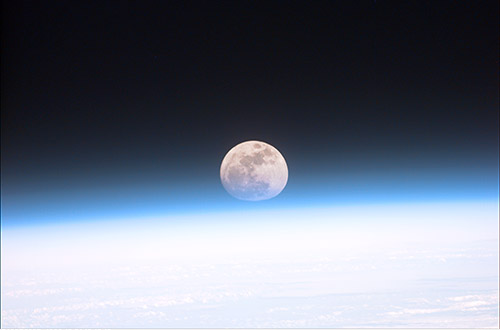From spectra collected during the August 2008 lunar eclipse,
astronomers have been able to investigate the in-transit signature of the Earth-Sun system as would be observed from outside the
solar system.
They found that the refraction of sunlight as it passes through a planetary atmosphere similar to the Earth's
contributes prominently to the
in-transit transmission spectrum and this contribution depends on the characteristics of the atmosphere, the size of
the host star, and the distance from the host star. This research has important implications for future attempts to characterise
the atmospheres of Earth-like
extrasolar planets, especially those in similar long-period orbits.
Lunar eclipses and exoplanetary transits are related phenomena. In both cases, a fraction of the light seen by an observer
is stellar light that has passed close to the planet's limb and, therefore, carries the
signature of any gaseous envelope. In fact, astronomers were able to detect the first extraterrestrial atmosphere from
observations carried out during the 1769 transit of Venus. Understanding the refraction of atmospheric sunlight is key to determining the
exact contribution by the lower and more dense layers of the transiting planetary atmosphere.
 |
Figure 1. Sunrises and sunsets offer daily demonstrations of the refraction of sunlight in the atmosphere.
Refraction is responsible for the phenomenon of the flattened Sun. Sunlight is bent more strongly the closer it is to the
horizon, which distorts the otherwise circular shape of the Sun. Tracing the actual trajectory of stellar-light rays has proven
critical to infer the spectral fingerprint of an Earth-like planet transiting its host star.
This figure shows, a flattened Moon as observed from space
(credit: http://spaceflight.nasa.gov/gallery/images/shuttle/sts-103/html/s103e5037.html) [ JPG ].
|
Now, astronomers have carried out a pioneering comparative investigation of lunar eclipses and exoplanetary transits,
using a common theoretical formulation that addresses in detail the transport of stellar light through the planet's
atmosphere.
The starting point was a set of
previously unpublished near-infrared spectra collected using LIRIS at the William Herschel Telescope at various phases during
the 2008 lunar eclipse. The team then used their theory to calculate how the in-transit signature of the Earth-Sun system would appear for
an observer outside the Solar System.
 |
Figure 2. Top: lunar eclipse spectrum observed using LIRIS at the WHT, and model simulation.
Middle: O 2, O 2-X, H 2O, CO 2 and CH 4 contributions to the model. Bottom: SCIAMACHY
solar occultation spectra measured from tangent altitudes of 7.1 and 9.5 km [ PNG ].
|
García Muñoz et al. (2012) show that the Moon in umbra receives unscattered sunlight that has been
refracted by a portion of the terrestrial atmosphere, while the diffuse sunlight that arrives
at the eclipsed Moon is scattered from the entire terminator. At mid-transit, refraction prevents
the Sun's rays from
passing through the low atmosphere and therefore the
refracted sunlight component comes from a higher annular ring that fully encloses the planet.
As a consequence, refraction imposes a limit on the atmospheric features that can be observed by a remote observer.
Indeed, at one astronomical unit, refraction prevents observation of the lower ~12 km of the
atmosphere and, therefore, the bulk of the spectroscopically active atmospheric gases.
References:
A. García Muñoz, M. R. Zapatero Osorio, R. Barrena, P. Montañés-Rodríguez, E. L. Martín,
and E. Pallé, 2012, "Glancing views of the Earth: from a lunar eclipse to an exoplanetary transit", ApJ, 755, 103. [ PDF ].



